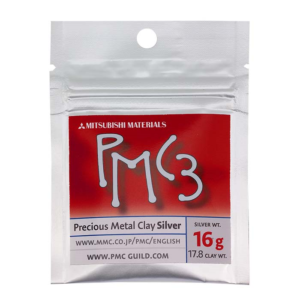First of all, PMC3 is not the android from Star Wars. Although they are both shiny, that is where the similarity ends. C3PO could be obnoxious and stubborn,(although he had a good heart) whereas PMC3 can be shaped and molded to your heart’s desire.
The original PMC was invented in Japan in the early 1990s by Masaki Morikawa. It is composed of microscopic particles of metals such as gold or silver in a non-toxic, organic binder that can be made into darn near anything. After it dries it is fired, causing the binder to burn away, leaving nothing but pure metal. You can get fine silver, gold or sterling silver in PMC, but for this article, we will focus on PMC3 which is fine silver or .999 pure.
Why PMC3? It has a longer working life than previous incarnations, which means that you can play with it longer before it starts to dry out and crack. You can use your hands or tools to shape it and you can use all kinds of materials to texture it. You can make little fiddly bits that would drive you insane to cut out with your saw. I have seen some amazing examples of tiny house lockets on the internet that have intricate details that you may never even dreamed of attempting previously. You can also get paste and slip form as well. Think about painting leaves or other botanicals with the slip to create beautiful organic jewelry that wouldn’t look out of place on a fairy or wood nymph. The paste can be used in molds and to add details to clay pieces before they are fired. There is really nothing that you can’t make with this amazing stuff!
PMC3 can be fired in a kiln or with a butane torch which is great if you can’t afford a kiln. Torch firing works well with small (charm sized) pieces only. Larger pieces must be fired in a kiln. Make sure that you follow directions carefully when firing so you don’t get a half-baked piece. A note of caution: however you fire PMC3, please do so in a well-ventilated space. Remember, if you’re injured, you can’t make jewelry and that is a sad thing.
PMC3 has a shrinkage rate of about 10% as compared to 30% for the original PMC which means that you will be able to produce pieces to set stones in with much more accuracy.This allows you to create jewellery with almost as much or as much detail as lost wax casting, and you don’t need to fling molten metal around!
As if this weren’t enough, you can also do phototransfer onto PMC3 for a two-sided pendant or earrings! Augh! I’m blowing my own mind!!!
So, add some Pretty Magical Clay to your jewellery repertoire today!
Pictures of these beautiful PMC pieces are courtesy of Liz McDonald
